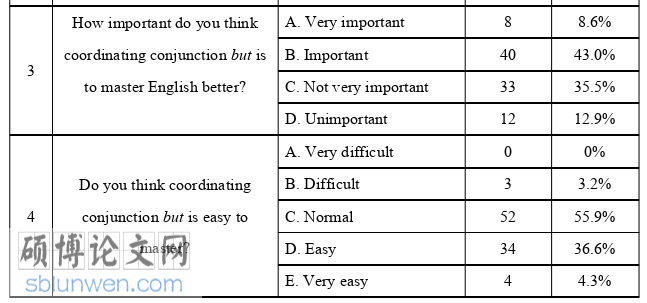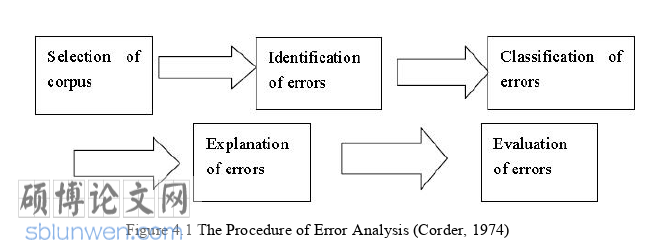本文是一篇英语论文,笔者提出了减少中国大学生英语写作中协调连接错误的对策。例如,激发学生对英汉差异的关注,提供充分正确的英语输入,提高学生的学习动机,提供清晰详细的解释。
Chapter OneIntroduction
1.1 Rationale
Language learners do not fully grasp and internalize language rules, resulting in thelanguage they output deviating from the target language, which is manifested in all levels ofthe language. This gap is called error (Lu, 1992; Luo& Sun, 2003), which is systematic andbelongs to the category of language competence (Corder, 1967). Different from Chinese,English is a morphological language achieving cohesion and coherence in writing mainlythrough grammatical devices. But is one representative coordinating conjunction in English,which plays an important role in the coherence of writing. However, previous studies of erroranalysis on EFL writing focus on the errors of verbs, prepositions, adjectives and nouns, withonly a few studies paying attention to the errors of conjunctions (Hu, 2016; Fan, 2020).Although some scholars studied the acquisition of but by Chinese EFL learners (Jiang, 2010;Chen, 2015), they did not pay attention to but errors in EFL writing.
Therefore, the author attempts to have an error analysis of coordinating conjunction butin Chinese college students’ EFL writing. Under the theoretical framework of InterlanguageTheory, along with sentences of but error collected in CLEC (Chinese Learners EnglishCorpus) and a questionnaire on the use of coordinating conjunction but in college students’English writing, this thesis aims to analyze the causes of different types of but error, and triesto put forward relevant countermeasures. This study can enrich the research on coordinatingconjunctions in the field of error analysis in Second Language Acquisition. In EFL learning, itcan promote students’ learning of cohesion and coherence devices in writing. In EFL teaching,teachers should make students aware of the importance of using but correctly, and let thempay attention to the influence of omission, addition and misformation of but on cohesion andcoherence.

英语论文怎么写
..........................
1.2 The Objective of the Thesis
This thesis, through error analysis of but in Chinese college students’ EFL writings,attempts to analyze and explain different error types of but. With the help of the InterlanguageTheory on this subject, along with sentences of but error from CLEC and a questionnaire onthe use of coordinating conjunction but in college students’ English writing, this thesis aimsto analyze the causes of different types of but error, and tries to put forward relevantcountermeasures.
The following three questions will be concerned in this study:
(1) What are the error types of coordinating conjunction but in Chinese college students’EFL writing?
(2) Based on the Interlanguage Theory, what are the possible causes for the errors ofcoordinating conjunction but in Chinese college students’ EFL writing?
(3) What measures can we take to reduce the errors of coordinating conjunction but inChinese college students’ EFL writing?
........................
Chapter TwoLiterature Review
2.1 Previous Studies of Error Analysis on EFL Writing
The error analysis on EFL writing has been paid increasing attention to by domestic andforeign scholars in the past few decades. Scholars at home and abroad have already analyzederrors in EFL writing from a variety of perspectives, such as the lexical perspective,grammatical perspective and the perspective from cohesion and coherence. Theseperspectives will be reviewed in the following part.
2.1.1 Error Analysis on EFL Writing at Home
Corder (1967) put forward the concept of “error” and distinguished it from “mistake”.He believed that “mistake” is accidental and belongs to the category of language performance,but “error” is systematic and belongs to the category of language competence. Their divisionis based on whether learners have sufficient language ability to complete a certain expression.Corder (1971) also pointed out that “error” is actually an integral part of learners’ languagesystem. It is called “error” because people measure it by external language standards. Thepurpose of Error Analysis is to analyze and study learners’ errors systematically, to determinethe source of errors, and to explain the psychological process of foreign language learning aswell as the position of error in learners’ language system (Zhu, 2007).
Some scholars at home have analyzed errors in EFL writing from the lexical perspective(Liu, 2009; Gu, 2010; Zhang & Liu, 2013). Liu (2009), Yu (2012), Shen (2012), Huang(2013), Zou (2014), Yuan (2016), Fu (2017) and Luo (2020) analyzed verb errors in EFLwriting. It was found that verb errors could be divided into subject-predicate inconsistency,verb-object collocation error, tense error, voice error, modal verb error and auxiliary verberror. They suggested that the methods of adding language input, peer error correction andface-to-face correction should be used to improve students’ English level (Shen, 2012). Mostof the researches on preposition errors are from the perspective of transfer. Zhang & Liu(2013) analyzed the rules of preposition learning and conceptual transfer of Chinese EFLlearners based on conceptual transfer theoretical framework in English acquisition. It wasfound that conceptual transfer at lexical and grammatical levels is obvious for Chinese EFLlearners, and it has systematic and unique characteristics. Their conceptual transfer theoreticalframework in English acquisition has been applied to the study of preposition errors ofChinese EFL learners by many scholars (e.g. Zhang, 2015; Liu, 2015; Sun, 2016; Yang, 2019;Sun, 2019; Hai, 2020). Chen (2004), Tan (2006), Zeng (2008), Zhong (2008), Yin (2009), Gu(2010), Pan (2011) and Hou (2016) analyzed the errors of adjectives and nouns in EFLwriting. It was found that the vast majority of errors are due to the influence of learners’ L1habits. These errors belong to “arbitrary collocation”, rather than “fixed collocation” (Pan,2011). And the causes of errors are related to intra-lingual interference, interlanguageinterference and communication strategies.
...........................
2.2 Previous Studies on but
The coordinating conjunction but has also been paid attention to by domestic and foreignscholars in the past years. Scholars at home and abroad have already studied but from severalperspectives, such as the pragmatic function of but and the acquisition of but. Both of theperspectives will be reviewed in the following part.
2.2.1 Studies on but at Home
Some scholars at home have studied the pragmatic function of but (Jin& Xie, 2007; Liu,2010). Jin& Xie (2007) first conducted a pragmatic analysis of but within the framework ofRelevance Theory to reveal the dynamics of natural language communication. They believedthat but plays different roles in different contexts, and in communication, context determinespragmatic function. But they did not analyze and study the specific functions of but indifferent contexts. Therefore, as a further research, from the perspective of the wholecommunication process and cognition, under the theoretical framework of Adaptation Theoryand Relevance Theory, combined with the research results on but of semantics and pragmatics,Jin (2008) revealed people’s psychological control behavior when using but to organizediscourse content and studied the motivation of the use of but and the role of but in helping tounderstand discourse. It was found that but not only has the function of cohesion, but alsoreveals the cognitive psychological track of language users. Liu (2008) explained thelinguistic features of but in courtroom. He found that but provides a pragmatic cognitiveguidance for the listener when he tries to find a connection between the discourse and thecontext and to obtain the optimal relevance, and but promotes the overall coherence of thediscourse. Similarly, the conclusion of this study is not very universal and is only applicableto the discussion of but in the field of court discourse. Wei& Liu (2009) found that in order torealize the speaker’s communicative intention and to guide the listener’s correctunderstanding of the discourse, but has a variety of pragmatic ostensive functions in verbalcommunication, such as negation, contrast, emphasis, supplement and correction. However,there are many other pragmatic ostensive functions of but in practical communication, whichneed to be further explored. Cao (2010) summarized the meaning and usage of the Englishconjunction but, and defined its adversative relationship. On this basis, she described fivemarked expressions of but in Chinese, and compared but with typical Chinese adversativeconnectives.
..........................
Chapter Three Theoretical Framework...........................10
3.1 Development of Interlanguage Theory........................................ 10
3.2 Core Concepts of Interlanguage Theory...................................... 11
Chapter Four Error Analysis of but Based on Interlanguage Theory................................14
4.1 Research Procedure.................................14
4.2 Error Types of but.............................. 15
Chapter Five Conclusion................................40
5.1 Major Findings..............................40
5.2 Limitations and Suggestions for Further Study........................ 40
Chapter FourError Analysis of but Based on Interlanguage Theory
4.1 Research Procedure
According to Corder (1974), the procedure of Error Analysis includes five steps. Figure4.1 shows the procedure of Error Analysis.

英语论文参考
The first step is to collect linguistic materials for analysis, and to identify the studentsintended to analyze.
The second step is to find out the errors in the materials, with taking into account thedistinction between “error” and “mistake”.
The third step is to classify errors according to a certain criterion and make descriptionsof errors.
The fourth step is to elaborate the causes of errors and correct them.
The last step is to analyze errors’ severity, to evaluate them, and to put forwardcorresponding strategies.
........................
Conclusion
5.1 Major Findings
Firstly, three error types of but were found in the chosen 100 sentences from CLEC.They are but omission, but addition and but misformation, and all can be further classifiedinto sub-types. But omission can be further classified into but omission between two clausesand but omission between two sentences. But addition can be further classified into butaddition in although/though...but..., but addition in main clause, meaning repetition andunnecessary use. But misformation can be further classified into but misformation with and,but misformation with however, but misformation with while and but misformation with otherconjunctions.
Secondly, causes of but errors were analyzed based on Interlanguage Theory. They areinter-lingual transfer which includes negative transfer and differences in thinking patterns,intra-lingual transfer which includes overgeneralization and ignorance of rules, strategies ofsecond language learning, and transfer of training.
Lastly, countermeasures were put forward to help reduce the errors of coordinatingconjunction but in Chinese college students’ EFL writing. For example, arousing students’attention towards differences between English and Chinese, providing sufficient and correctEnglish input, promoting students’ motivation, and providing clear and detailed explanations.
reference(omitted)
